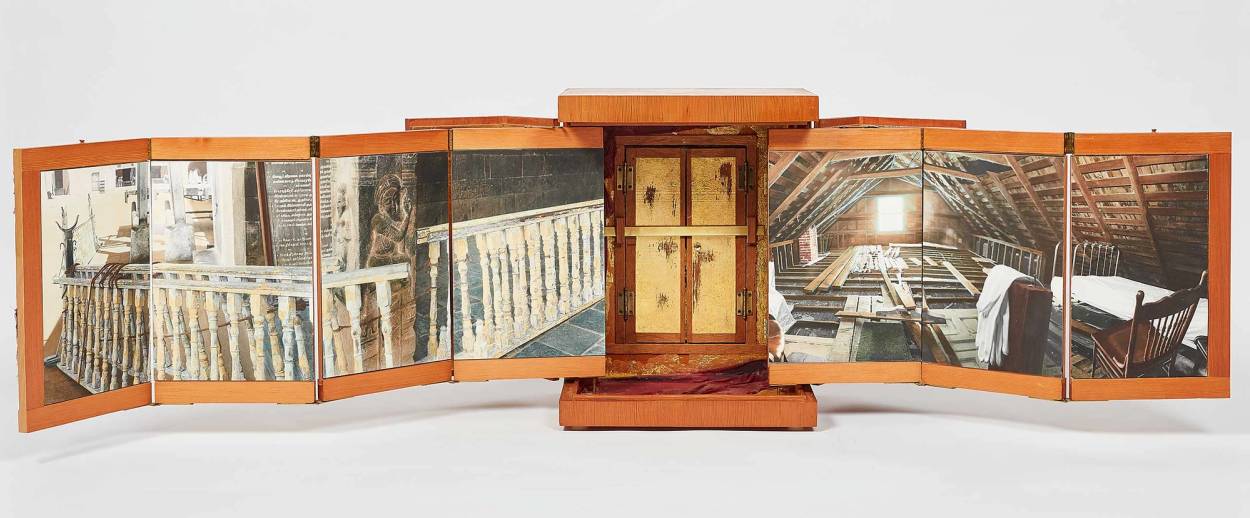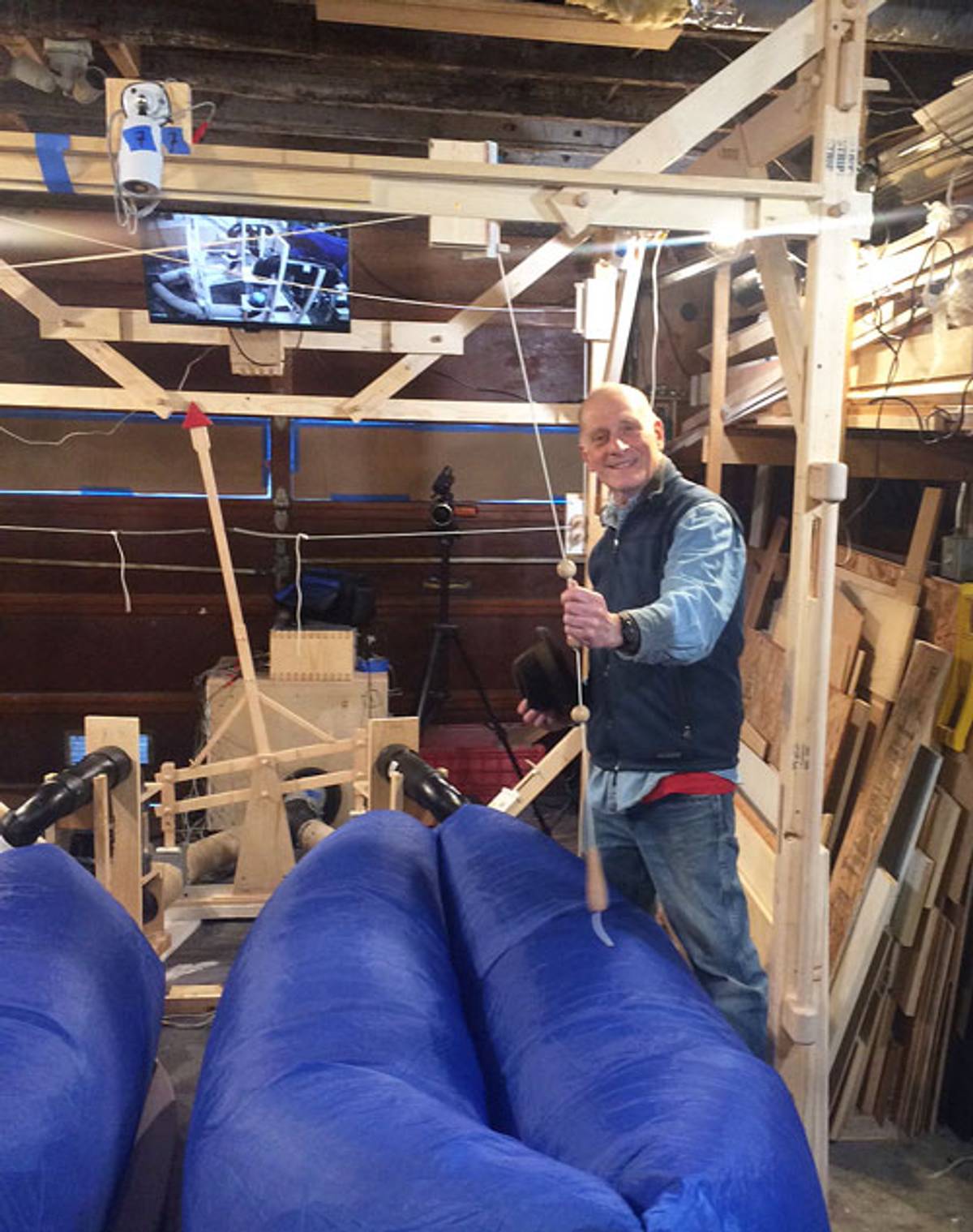Jewish Contraptions
National Poetry Month: A poetical Bay Area exhibit brings together California Jewish artists who make wonky machines, ‘anxious objects,’ and other kinetic commentaries on the ‘labor-saving devices’ of our current entanglement




To go to an art exhibit and meet the artist, lingering near his creation, is a rare treat. But to discover that the artist is there to fix his work—for the third time in one week—is to find oneself inside an exhibit of a whole new order, where the old rules, separating the untouchable art, invisible artists, and audience, no longer apply. And so, when I ran into Bernie Lubell at the Contemporary Jewish Museum’s Contraption exhibit, fiddling with his kinetic art installation “Theory of Entanglement,” it became clear that Lubell’s “machine,” at once sophisticated and fragile, is far more human-like than the traditional art forms I grew accustomed to encountering in a museum setting.
Contraption is an exhibit that brings together California Jewish artists whose subject is a peculiar sort of a machine: As one of the artists, Bella Feldman, indicated in an exhibit label, “I produce anxious objects, yet humor laces through my work because, like my ghetto forbears, I need to laugh at the dark.” Apparently, her artwork had been acting up as well, because at the time of my visit only docents were allowed to touch it. As the accompanying docent repeatedly swung a crank on a wheel, wobbly mechanisms set off a number of seemingly disconnected effects, causing a small metal ball to pitifully dangle, until finally, and anxiously, the ball reached a bell, and rang out, to an admixture of relief, bewilderment, and amusement of the gathered audience.

The Bay Area—and its shadow double, Silicon Valley—is the perfect location for an exhibit like this one. Here, highly advanced and often wonky machinery is not confined to labs and closed campuses—it is everywhere. This became clear to me, one day during my first year on the West Coast, while sitting at a small Palo Alto library, where I was approached by a remote-operated wheeled device with an attached monitor featuring the librarian’s smiling countenance. The thing nearly stumbled over me, as it halted to ask if I needed anything. I must have looked so taken aback that the librarian, via a built-in speaker, proceeded to gleefully explain that they were testing a new form of customer service—was I pleased? After a confirmation, the device moseyed on, stopping near every patron, including some groggy old-timers, none of whom even flinched. I supposed they’d seen that kind of thing before.
Over email, the exhibit’s curator, Renny Pritikin, explained that the theme emerged when he and his colleague Mark Dean Johnson of San Francisco State University surveyed more than a hundred Jewish California artists. According to Pritikin, among those surveyed, “a large group referred literally or poetically to the idea of the machine, or the contraption. So we went with that as the theme of the show, thinking Rube Goldberg to Bernie Lubell.”
Cartoonist Rube Goldberg might be the most easily recognizable name in the exhibit. As Pritikin pointed out, Goldberg’s work showed how “labor-saving devices were indeed often more trouble than they were worth, which is the point of all his device drawings.” While Goldberg’s drawings are featured in the Contraption exhibit, the Contemporary Jewish Museum also has an entire exhibition now open dedicated to Goldberg’s work: The Art of Rube Goldberg. In addition to contraption-related drawings, the exhibit also explores Goldberg’s far-reaching influence on the Marx Brothers, the Three Stooges, and Charlie Chaplin, whose film Modern Times features an epic eating-machine scene, reminiscent of so many of Goldberg’s sketches.
***
More than 70 years ago, in the introduction to his poetry collection The Wedge, William Carlos Williams famously wrote that “a poem is a small (or large) machine made out of words,” adding that in a poem, “there can be no part, as in any other machine, that is redundant.” I thought of Williams’s line last week, when I came to visit Bernie Lubell in his Bernal Heights studio. It occurred to me that Lubell’s contraptions are poems—made out of (mostly) wood. Wood is Lubell’s material of choice. The fragility of a machine made out of wood gives his artwork “a human quality,” he said. And because “the parts have to be bigger so that they don’t break all the time,” the object becomes “a machine that’s working but it is also a cartoon of the machine that’s working.”

Lubell took me to his garage basement to see “Aspirations,” a new piece that features two inflatable bags with cords attached above them. There’s not enough air for both bags, which means that if two people were to try to lounge on these at the same time—as Lubell and I did—only one bag would be sufficiently inflated and the other person would need to pump some additional air by pulling the cord, which would in turn lead the other person’s bag to deflate. The social commentary mixed with the awkwardness of shuffling inside the blue bag while pulling on the hopeful rope was the stuff of poetry, as were the negotiations that inevitably erupted, and the eventual banter.
Later, as we sat in Lubell’s office and I pored over his bookshelves, I was pleasantly surprised to discover not only the usual artist’s fare of art and literature books but also volumes on engineering and physics, with a whole shelf that appeared to be dedicated to time. Lubell went to college to study engineering but fell in love with literature and art and his installations indeed seem to bring together both his passions. The New York-born septuagenarian spent much of his life engaged in manual labor in the construction industry.
We spoke about Lubell’s “Theory of Entanglement,” featured in the Contemporary Jewish Museum—a large installation with a station for two pedaling bikers who are instructed “Think of this as a 3-Way Dance.” A small sign next to the biking station indicates: “labor.” Nearby there’s a small bench with a sign “capital.” If someone sits on the bench while the bikers pedal, a series of levers cause the machine to knit a big and ominous black mesh stocking, suspended from somewhere up above. Literal entanglement—the knitting—of the yarn is mirrored by entanglement of economic forces in a capitalist society, as well as a more personal, relational entanglement of those who ride through life, facing one another—as partners, family members, or friends.
The installation’s name, as Lubell clarified to me, is a reference to string theory and the idea that if two particles had once been entangled, they will continue to act in tandem, even if positioned at separate ends of the universe. Einstein derisively called the effect “spooky action at a distance,” but as Lubell pointed out, the theory had a great deal more proof and support after Einstein’s time, now that testing of fast-moving particles has become more possible. And this theory, said the artist, throws our notions of cause and effect out the window.
When I asked the artist whether the attraction to kinetic art—particularly contraptions—had anything to do with Jewishness, Lubell, who grew up secular, seemed skeptical: “I suspect there is no real connection.” Yet, further reflecting, he suggested: “Jews have always been excluded from things. Being outside—and I always felt outside—of the standard culture… you’re able to reflect on it. And the modern situation is all about the machines in our lives, and how they managed to take over.”
Pritikin sees a direct line between the Jewish story and the art of contraptions: “I believe for immigrant people, as newcomers and outsiders, society can appear to be a gigantic machine and they don’t have the instruction booklet for how to maneuver one’s way through it. So this was relevant to the early Jewish arrivals” in America. Moreover, Pritikin pointed out, there may be more historical resonance in the concept, given that “a contraption is a slapped together device using modest at-hand materials to accomplish a specific task by people without access to the best materials. It is an improvised way of getting by for the poor.” Contraption, then, is a Kafkaesque mirror held up to poverty—of not only physical but also ontological materials. This mechanics of odd and illogical human interaction reflects a penchant for systems that have little to do with efficiency and are more about randomness, curiosity, anxiety, trauma, and mystery.
Some of these emotions figure strongly in “Watershed D” by Howard Fried. His piece features a closed door, which, if opened, leads into a room with an ironing board, and an iron. Yet, as the door swings, without a discernible pattern, a secret portrait-sized opening in the wall to the side suddenly reveals a board with writings—free-associative poetic ramblings by the artist himself: “Today I cried for the first time in several years; I cried for a very short time when I was overcome with confusing and multifarious emotions somehow connected with the lack of fulfillment of my intentions relative to two works.”
What I enjoyed most was watching others as they cautiously approached the door, backed away from it altogether or perhaps entered, and then raced back to look at the writing, which, before long, swung closed. As they tried to pry the door open, the wall remained closed, and the “writing on the wall” would no longer be available. It was a bit like Kafka’s gate where the guard is replaced by an unreliable mechanism.
When I asked Pritikin about the fragility of the contraptions featured in the exhibit, and the occasional breakdowns, he pointed to Kevin Kelly, the founder of Wired magazine who, as Pritikin recalled, once said something to the effect of “when inventions reached the point when they could reliably be counted on to work properly, he lost interest in them.” Pritkin added: “So riding the edge of that wave keeps things juicy. On the other hand people do get frustrated if things aren’t working so we like to keep them going. I’m not sure things have to be kinetic to keep folks’ attention nowadays, but exhibitions do have to find a way to talk to the contemporary way that people live and think.”
At this exhibit, the audiences won’t find the sleek machines populating the dreams and demo videos of the Silicon Valley startups. They’ll find clunky, awkward, ridiculous but profoundly affecting mechanisms that will remind us above all of the most outdated technological golems: ourselves.
***
Celebrate National Poetry Month with Tablet’s deep archive of articles about poetry and poets.
Jake Marmer is Tablet’s poetry critic. He is the author of The Neighbor Out of Sound (2018) and Jazz Talmud (2012). His jazz-klezmer-poetry record Hermeneutic Stomp was released by the Blue Thread Music in 2013.
Jake Marmer is Tablet’s poetry critic. He is the author of Cosmic Diaspora (2020), The Neighbor Out of Sound (2018) and Jazz Talmud (2012). He has also released two jazz-klezmer-poetry records: Purple Tentacles of Thought and Desire (2020, with Cosmic Diaspora Trio), and Hermeneutic Stomp (2013).